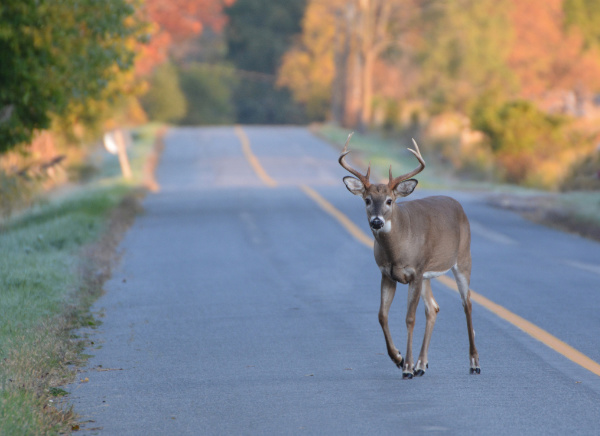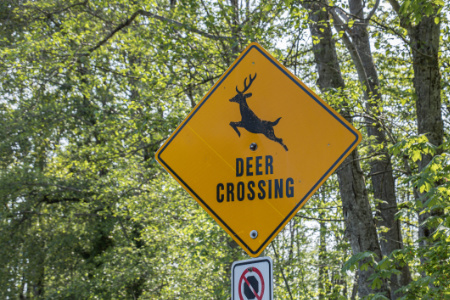
Wildlife encounters are a reality for anyone who travels out of Canada’s big cities. In British Columbia alone, 570 motorists are injured and three are killed every year due to these encounters. And the Insurance Corporation of British Columbia estimates that 11,000 animal-related collisions happen every year. While steps have been taken in Banff to drastically reduce the number of wildlife collisions, the risk is still present.
You can prepare for wildlife encounters in two ways:
- Understand and review your coverage relating to animal collisions.
- Create a roadside emergency preparedness kit.
Different coverages for different situations
The two auto coverages that relate to animal collisions are collision and comprehensive. While collision seems like a no-brainer, comprehensive is the one you need the most.
Here is how each coverage would be triggered in most provinces:
Your vehicle collides with a dead deer. Collision insurance covers collisions with moving vehicles and inanimate objects. If you have collision coverage, damages to your vehicle are covered after you’ve paid your deductible.
A deer collides with your vehicle. Comprehensive insurance covers you, unless otherwise mentioned or excluded from your policy. If you have this coverage, your vehicle will be repaired after you’ve paid your deductible. Note that the deductible for comprehensive insurance is usually lower than the deductible for collision insurance.
Since both of these coverages are optional, consider adding them to your policy if you haven’t done so already. Check with your insurance professional to make sure your policy covers animal collisions.
In Quebec, a collision with a living animal is considered an at-fault accident. You will be able to repair your vehicle if you have collision coverage, but your premium may increase at renewal.
If you can’t avoid a collision, don’t brake unnecessarily or swerve before assessing where other drivers are, as you don’t want to make a bad situation worse. Warn everyone in the vehicle to brace for impact, then assess the damage.
Driver and passenger injuries are covered by accident benefits coverage. Accident benefits are mandatory in all provinces, though they are sometimes called by different names: Section B benefits in Alberta, Personal Injury Protection Plan in Manitoba, etc. The minimum amount of coverage required by law may be too low for your needs if you or your passenger suffers a major injury.
In Quebec, injury coverage is provided by the Société de l’assurance automobile du Québec (SAAQ) for anyone involved in a car accident, even tourists and residents of other provinces.
Have your insurance professional advise you on the best coverage for you and your family to avoid any major out-of-pocket expenses.
What to do before and during the accident

Prepare for an animal collision as you would for any unforeseen road-related event. Pack an emergency first-aid kit with flares, a flashlight, roadside reflectors, blankets and a small supply of food and water. Make sure your hazard lights and headlights work and that your tires and brakes are in good shape.
Deer and other animals are most active at night, including dusk and dawn. Be mindful of road conditions and respect the speed limit to ensure you have enough time to brake. Keep an eye out for animal crossing signs and scan the road ahead.
If you can’t avoid a collision, don’t brake unnecessarily or swerve before assessing where other drivers are, as you don’t want to make a bad situation worse. Warn everyone in the vehicle to brace for impact, then assess the damage.
What to do after the accident
Pull over to a safe area, away from traffic. Turn off the engine. Put on your hazards.
Are you injured? Are your passengers? Have everyone exit the vehicle if they can move. Check their condition and tend to any wounds. If someone is severely injured, do not attempt to move them. Accidents can cause shock. Check vital signs and keep everyone calm and shielded from the cold. Use your blankets.
Call 911 and set up flares around the vehicle and animal to prevent other collisions. Once you’ve covered the bases, wait for the police and first responders to arrive at the scene, then fill out a police report.
Call your insurance company to file your claim. If your car needs to be towed, they will tell you how to proceed at no cost to you. It’s part of your comprehensive coverage and is also available if you have roadside assistance.
If the animal is injured, keep away for your own safety and let the 911 dispatcher know.
Call your insurance broker to update your coverage or ask any questions you may have about auto insurance and animal collisions.




Reliance Insurance proudly serves
Burnaby and the Vancouver area